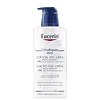What's inside
What's inside
 Key Ingredients
Key Ingredients

 Benefits
Benefits

 Concerns
Concerns

 Ingredients Side-by-side
Ingredients Side-by-side

Water
Skin ConditioningUrea
BufferingGlycerin
HumectantIsopropyl Stearate
EmollientDicaprylyl Ether
EmollientGlyceryl Glucoside
HumectantSodium Lactate
BufferingButyrospermum Parkii Butter
Skin ConditioningPolyglyceryl-4 Diisostearate/Polyhydroxystearate/Sebacate
EmulsifyingTapioca Starch
Carnitine
CleansingCetearyl Alcohol
EmollientCeramide NP
Skin ConditioningArginine Hcl
Skin ConditioningSodium PCA
HumectantHistidine Hcl
Skin ConditioningLactic Acid
BufferingMannitol
HumectantArginine
MaskingSerine
MaskingSucrose
HumectantPCA
HumectantCitrulline
Skin ConditioningGlycogen
HumectantAlanine
MaskingThreonine
Glutamic Acid
HumectantLysine Hcl
Skin ConditioningSodium Chloride
Masking1,2-Hexanediol
Skin ConditioningPhenoxyethanol
PreservativePotassium Sorbate
PreservativeWater, Urea, Glycerin, Isopropyl Stearate, Dicaprylyl Ether, Glyceryl Glucoside, Sodium Lactate, Butyrospermum Parkii Butter, Polyglyceryl-4 Diisostearate/Polyhydroxystearate/Sebacate, Tapioca Starch, Carnitine, Cetearyl Alcohol, Ceramide NP, Arginine Hcl, Sodium PCA, Histidine Hcl, Lactic Acid, Mannitol, Arginine, Serine, Sucrose, PCA, Citrulline, Glycogen, Alanine, Threonine, Glutamic Acid, Lysine Hcl, Sodium Chloride, 1,2-Hexanediol, Phenoxyethanol, Potassium Sorbate
Water
Skin ConditioningGlycerin
HumectantGlyceryl Glucoside
HumectantSimmondsia Chinensis Seed Oil
EmollientHydrogenated Coco-Glycerides
EmollientCaprylic/Capric Triglyceride
MaskingIsopropyl Palmitate
EmollientSynthetic Beeswax
Emulsion StabilisingGlyceryl Stearate Citrate
EmollientDistarch Phosphate
AbsorbentOctyldodecanol
EmollientPentylene Glycol
Skin ConditioningPanthenol
Skin ConditioningCetyl Alcohol
EmollientStearyl Alcohol
EmollientSodium Hyaluronate
HumectantNiacinamide
SmoothingGlycine
BufferingAlanine
MaskingCarbomer
Emulsion StabilisingTocopheryl Acetate
AntioxidantDimethicone
EmollientCaprylyl Glycol
EmollientPhenoxyethanol
PreservativeWater, Glycerin, Glyceryl Glucoside, Simmondsia Chinensis Seed Oil, Hydrogenated Coco-Glycerides, Caprylic/Capric Triglyceride, Isopropyl Palmitate, Synthetic Beeswax, Glyceryl Stearate Citrate, Distarch Phosphate, Octyldodecanol, Pentylene Glycol, Panthenol, Cetyl Alcohol, Stearyl Alcohol, Sodium Hyaluronate, Niacinamide, Glycine, Alanine, Carbomer, Tocopheryl Acetate, Dimethicone, Caprylyl Glycol, Phenoxyethanol
 Reviews
Reviews

Ingredients Explained
These ingredients are found in both products.
Ingredients higher up in an ingredient list are typically present in a larger amount.
Alanine is an amino acid and is already found in the human body. Our skin uses alanine to build collagen, elastin, and keratin.
Glycerin is already naturally found in your skin. It helps moisturize and protect your skin.
A study from 2016 found glycerin to be more effective as a humectant than AHAs and hyaluronic acid.
As a humectant, it helps the skin stay hydrated by pulling moisture to your skin. The low molecular weight of glycerin allows it to pull moisture into the deeper layers of your skin.
Hydrated skin improves your skin barrier; Your skin barrier helps protect against irritants and bacteria.
Glycerin has also been found to have antimicrobial and antiviral properties. Due to these properties, glycerin is often used in wound and burn treatments.
In cosmetics, glycerin is usually derived from plants such as soybean or palm. However, it can also be sourced from animals, such as tallow or animal fat.
This ingredient is organic, colorless, odorless, and non-toxic.
Glycerin is the name for this ingredient in American English. British English uses Glycerol/Glycerine.
Learn more about GlycerinGlyceryl Glucoside is made from glycerol and glucose.
It is a humectant. Humectants help hydrate your skin by drawing moisture to it from the air.
Some foods that contain glyceryl glucoside include sake, miso, and wines.
Learn more about Glyceryl GlucosidePhenoxyethanol is a preservative that has germicide, antimicrobial, and aromatic properties. Studies show that phenoxyethanol can prevent microbial growth. By itself, it has a scent that is similar to that of a rose.
It's often used in formulations along with Caprylyl Glycol to preserve the shelf life of products.
Water. It's the most common cosmetic ingredient of all. You'll usually see it at the top of ingredient lists, meaning that it makes up the largest part of the product.
So why is it so popular? Water most often acts as a solvent - this means that it helps dissolve other ingredients into the formulation.
You'll also recognize water as that liquid we all need to stay alive. If you see this, drink a glass of water. Stay hydrated!
Learn more about Water